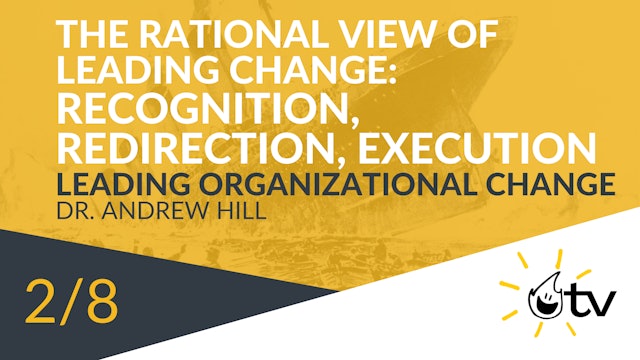Leading Organizational Change
Change is inevitable, and we don't seem to be very good at dealing with it. Join us in this introduction to leading organizational change as we explore three ways to think about it. The first is the “Rational View”, which says that change leadership has three parts: recognition, redirection, and execution. Do those things well, and you’re good. However, we all know it’s not that simple. Anytime people are involved, things can get complicated. The second is the “Natural View” of leading change. This involves ideas that explore how essentially passive forces like how we think, organizational culture, routines, professional influence, and incentives affect people’s behavior, and can make change much more difficult to implement, especially if leaders don’t pay attention to them. The third category of thought on leading change is the “Political View”. These perspectives emphasize the ways in which successful change leadership often require political activity to persuade people to accept a new goal for the organization or new ways of doing things. Our purpose here is to introduce some basic ideas about change that you’ll find useful, and help increase your chances of successfully leading change in your organizations and teams.
-
Introduction to Leading Organizational Change
Change is a constant in all organizational life and one of the biggest leadership challenges.
-
The Rational View of Leading Change: Recognition, Redirection, Execution
Recognize, redirect, execute--if natural and political factors didn't affect how we lead change, the challenge would be a lot more straightforward, though still not simple.
-
Cognition: Natural Views of Leading Change
How we think--the biology and psychology of cognition--is a major factor in leading change, because our understanding of the present and future is limited.
-
Culture: Natural Views of Leading Change
What's the connection between organizational culture and change? A strong culture as great when the organization doesn't need to change, but when it does, a strong culture can be a big problem.
-
Routines: Natural Views of Leading Change
It's hard to change what you don't see. One of the hardest aspects of leading change is the way that some of the things we do become taken-for-granted routines that we don't even think about.
-
Disruptive Innovation: Natural Views of Leading Change
You may have heard of "disruptive innovation", but what is it? Disruptive innovation explores why dominant firms fail when their markets change. How do the incentive structures of market-leading organizations prevent them from pursuing necessary changes?
-
Kotter's 8 Steps: Political Perspectives on Change
Let's explore John Kotter's eight steps for leading change: 1. Create a sense of urgency; 2. Build a guiding coalition; 3. Create a vision; 4. Communicate the vision; 5. Empower others to act; 6. Generate short-term wins; 7. Consolidate and sustain change; 8. Institutionalize new approaches. It'...
-
Transformational Leadership: Political Perspectives on Change
James MacGregor Burns describes how transactional leaders lead change by giving us what we want, but transformational leaders lead change by inviting us to want something we may not have imagined was possible.
-
Andrew Hill Bio
745 KB
Before co-founding BurnBright, Andrew was a professor at the U.S. Army War College, where he taught senior national security professionals. As the War College's first Chair of Strategic Leadership, Andrew's research focused on connecting people, strategy, and innovation. He has a doctorate from H...











